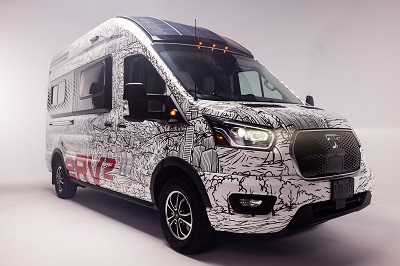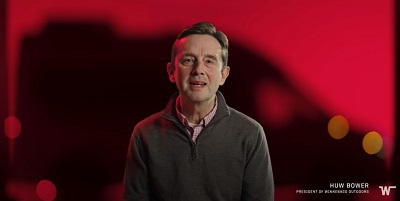
Winnebago debuted one of its 12 prototype eRV2 Type B motorhomes at the Tampa SuperShow in Florida last week. Company President Huw Bower said the manufacturer’s digital capabilities are “significantly enhanced” from the concept motorhome introduced at the 2022 Tampa SuperShow.
“Our digital savvy and our digital capabilities have matured leaps and bounds in the last 18 months,” he said. “That is important when you have an electric vehicle because there is an ecosystem of benefits that people expect with an electric vehicle.”
Although Winnebago conducted consumer test drives of the prototype in Tampa, Bower said the schedule for full production remains unchanged. The plan is to obtain six months of consumer testing with the 12 prototype vehicles. Bower said the time will enable Winnebago to iron out consumer use cases and deeply understand how the RV will be used and charged, as well as what experiences RVers expect once they take the motorhome camping.
From there, Winnebago plans to continue improvements—particularly in mileage range between charges—with plans to begin production in 2024 for a 2025 model year vehicle.
 “These prototypes are very worthy,” he said. “They are high-quality prototypes that we are incredibly proud of. Candidly, range in this current prototype does not support a commercial-use case. The vehicle that we commercialize will have a greater range than this current prototype.”
“These prototypes are very worthy,” he said. “They are high-quality prototypes that we are incredibly proud of. Candidly, range in this current prototype does not support a commercial-use case. The vehicle that we commercialize will have a greater range than this current prototype.”
Winnebago said during the unveiling at Tampa the current prototype range is 108 miles between recharges, which is based on Ford’s e-Transit chassis.
As the manufacturer closes with 18-24 months of full production, Bower said collaboration with dealers has been underway. Among the talks with “key, trusted strategic partners” are discussions over the potential electric adoption pace, price points, use cases and how dealers can add value in the sales and service process.
“We have partnership discussions with these dealers going forward, and in earnest,” he said. “We think there is an awful lot of value we can add through the selling and education process for consumers. It also requires a very close collaboration with our dealer partners.”
Among the critical talking points is dealer infrastructure needs to meet charging requirements and service capabilities for an all-electric RV.
“There is no doubt there are going to be infrastructure requirements for dealers who are capable of selling and servicing this sort of product,” Bower said. “We have to be realistic. I am not forecasting a massive shift into electric demand anytime soon, but there is no doubt there are real consumers who want to start experimenting and seeing what this lifestyle could be like.”
Among the eRV2 prototype’s advances Bower highlighted upon the Tampa release, he said Winnebago has made major strides in its proprietary IonBlade lithium house battery system. The 48-volt system was created in partnership with Lithionics Battery and provides over 15,000 usable watt-hours.
“We have matured a number of different capabilities internally,” Bower said, “from mastering high-voltage electric systems, putting together manufacturing plans for electric vehicles, setting up supply chains for more sustainable products to build into these vehicles, and setting up an integrated, connected ecosystem that puts a connection between the consumer, their phone and the vehicle for the first time in our Winnebago fleet.”




